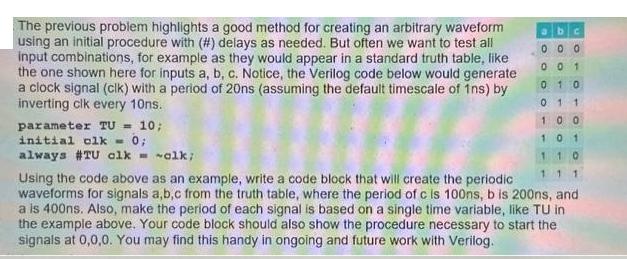Answered step by step
Verified Expert Solution
Question
1 Approved Answer
The previous problem highlights a good method for creating an arbitrary waveform using an initial procedure with (#) delays as needed. But often we

The previous problem highlights a good method for creating an arbitrary waveform using an initial procedure with (#) delays as needed. But often we want to test all input combinations, for example as they would appear in a standard truth table, like the one shown here for inputs a, b, c. Notice, the Verilog code below would generate a clock signal (clk) with a period of 20ns (assuming the default timescale of 1ns) by inverting clk every 10ns. parameter TU = 10; initial clk = 0; always #TU clk = ~olk; 001 010 011 100 101 110 1 Using the code above as an example, write a code block that will create the periodic waveforms for signals a,b,c from the truth table, where the period of c is 100ns, b is 200ns, and a is 400ns. Also, make the period of each signal is based on a single time variable, like TU in the example above. Your code block should also show the procedure necessary to start the signals at 0,0,0. You may find this handy in ongoing and future work with Verilog.
Step by Step Solution
★★★★★
3.41 Rating (160 Votes )
There are 3 Steps involved in it
Step: 1
Solution to the circuit shown in the image i The total resistance The total resistance in the circuit is the sum of the resistances of all the resistors in the circuit Total resistance 10 20 40 70 ii ...
Get Instant Access to Expert-Tailored Solutions
See step-by-step solutions with expert insights and AI powered tools for academic success
Step: 2

Step: 3

Ace Your Homework with AI
Get the answers you need in no time with our AI-driven, step-by-step assistance
Get Started


